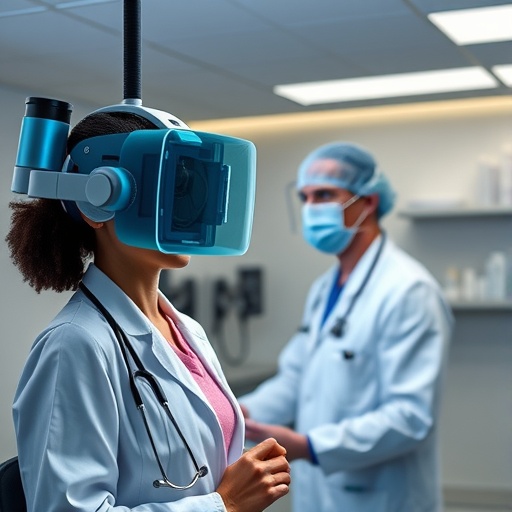
In recent years, the integration of virtual platforms into educational frameworks has surged, particularly in clinical training environments. Institutions are increasingly recognizing the significance of virtual clinical immersion programs, which enhance students’ experiential learning without the necessity for physical relocation or traditional in-person experiences. A notable study examined these innovative methods and their implications for medical education, yielding insightful conclusions that could transform how future practitioners are trained.
The primary focus of this study revolves around the efficacy of virtual clinical immersion, a modality designed to bridge the gap between theoretical knowledge and practical application. Virtual clinical immersion allows students to engage with simulated clinical scenarios, thereby honing their skills in a controlled and supportive environment. This approach not only alleviates the common logistical challenges associated with traditional clinical placements but also ensures that students are exposed to a wide array of clinical conditions and treatments.
Moreover, the adoption of this technology is timely, as the healthcare landscape continues to evolve rapidly. The challenges posed by recent global events, such as the COVID-19 pandemic, have underscored the need for flexible and scalable training solutions. Virtual immersion offers a viable answer, enabling students to develop clinical competencies even during times when in-person interactions are limited. This adaptability could prove critical in preparing a workforce ready to confront future healthcare challenges.
The findings of the study led by Brennan-Pierce, Stanton, and Dunn contribute significantly to the ongoing discourse on medical education reform. Their research illustrates not only the user-friendliness of virtual platforms but also the diverse applications that can enhance learning outcomes. By utilizing advanced simulations that replicate actual patient interactions, students are more prepared to engage effectively with real patients in clinical settings. The immersive experience fosters a deeper understanding of the nuances of patient care, which can be difficult to achieve through rote learning alone.
Furthermore, the study emphasizes the importance of interactivity in educational outcomes. Traditional lecture-based formats often fall short in fostering engagement, whereas virtual clinical immersion encourages active participation. Students can practice critical thinking and decision-making skills as they navigate complex clinical scenarios, receiving immediate feedback on their actions. This interactive component is crucial as it mirrors the unpredictability of real-world clinical situations, better preparing students for the challenges they will face in their careers.
In terms of accessibility, virtual clinical immersion programs can be particularly beneficial for students who may face obstacles in attending traditional placements due to geographical or financial constraints. By leveraging technology, educational institutions can create more inclusive training opportunities that are accessible to a broader range of students. This inclusivity not only enriches the learning experience but also contributes to a more diverse healthcare workforce.
Another exhilarating aspect of these findings is the potential for continuous assessment and feedback. Unlike traditional clinical placements, where feedback can sometimes be limited or delayed, virtual platforms provide immediate critiques and guidance. Students can swiftly rectify mistakes and reinforce learning, leading to a more effective educational process. This continual feedback loop is essential for skill development in an increasingly competitive field where precision and expertise are paramount.
Additionally, the implications of virtual clinical immersion extend beyond mere skill acquisition; they foster a sense of community among learners. Online platforms allow students to collaborate, share experiences, and support one another, thereby creating a network of peers that can provide emotional and professional support throughout their training. This sense of belonging can enhance motivation and resilience, vital attributes for anyone entering the demanding field of healthcare.
In the global context, the use of virtual clinical immersion is a compelling opportunity to standardize education across regions with differing levels of access and resources. By implementing a uniform virtual training program, educational institutions can ensure that all students, regardless of their physical location, receive equally high-quality training. This approach not only elevates educational standards but also aids in addressing disparities that exist within the healthcare system.
As new technologies continue to emerge, the potential for augmenting virtual clinical immersion with artificial intelligence and machine learning is significant. These technologies can personalize learning experiences based on individual student needs, adapting scenarios to optimize engagement and skill acquisition. The combination of AI with immersive technology represents a frontier in education that can redefine the paradigm of training future healthcare professionals.
In summation, the insights presented by Brennan-Pierce, Stanton, and Dunn herald a pivotal shift in the landscape of medical education. The findings underscore the value of virtual clinical immersion programs as effective tools for developing competent and confident healthcare practitioners. As educational institutions begin to fully embrace these innovations, the implications could reverberate throughout the healthcare sector, ultimately enhancing patient care and outcomes on a global scale.
In conclusion, while traditional clinical education remains invaluable, the integration of virtual immersion techniques presents astonishing possibilities. The study highlights not only the practical implications of these programs but also their role in reshaping and future-proofing medical education. As we continue to explore the intersection of technology and education, it is evident that the future of healthcare training is being redefined in profound and exciting ways.
Subject of Research: Virtual Clinical Immersion in Medical Education
Article Title: Insights from a Virtual Clinical Immersion Program
Article References:
Brennan-Pierce, E.P., Stanton, S.G. & Dunn, J.A. Insights from a Virtual Clinical Immersion Program.
Biomed Eng Education 5, 37–45 (2025). https://doi.org/10.1007/s43683-024-00156-4
Image Credits: AI Generated
DOI: https://doi.org/10.1007/s43683-024-00156-4
Keywords: Virtual Clinical Immersion, Medical Education, Training, Healthcare, Technology Integration, Accessibility, Skill Development, Innovation
Tags: benefits of virtual training in medical fieldsbridging theoretical knowledge and practical applicationchallenges in traditional clinical placementsenhancing clinical competencies through virtual platformsevolving healthcare training solutionsexperiential learning in healthcare educationflexible medical education during pandemicsfuture of medical training and educationinnovative methods in clinical educationsimulated clinical scenarios for medical studentstechnology in healthcare educationvirtual clinical immersion programs




